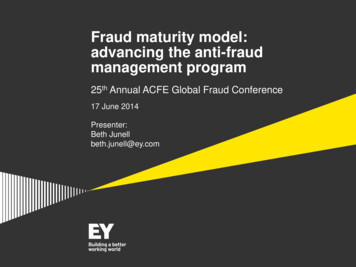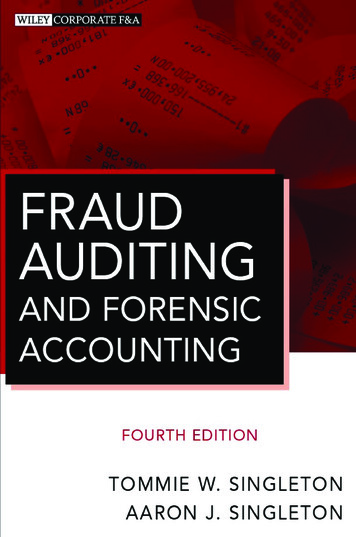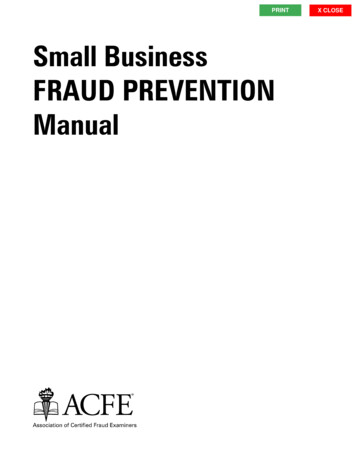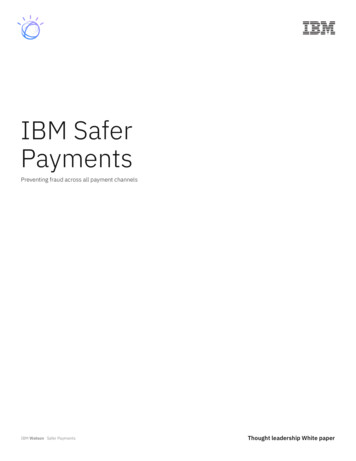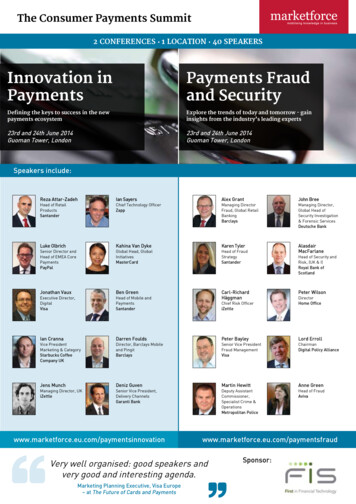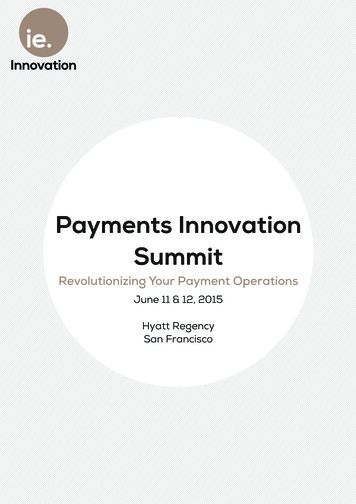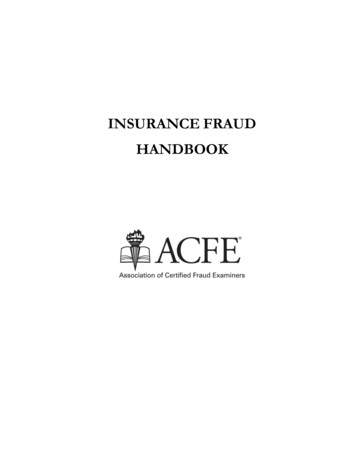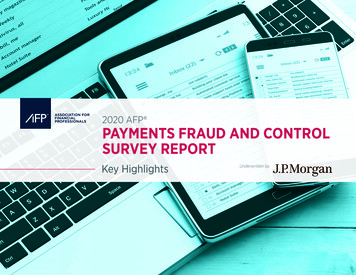
Transcription
2020 AFP PAYMENTS FRAUD AND CONTROLSURVEY REPORTKey Highlights2020 AFP Payments Fraud and Control Report: Key Highlights www.AFPonline.orgUnderwritten by1
2020 AFP PAYMENTS FRAUD ANDCONTROL SURVEY REPORTKey HighlightsApril 20202020 AFP PAYMENTS FRAUD AND CONTROL SURVEY REPORTthis summary report includes highlights from the comprehensive2020 AFP Payments Fraud and Control Survey Report. The completereport comprising all findings and detailed analysis is exclusivelyavailable to AFP members. Learn more about AFP membership.Underwritten by2020 AFP Payments Fraud and Control Report: Key Highlights www.AFPonline.org2
TOPICS COVERED IN THECOMPREHENSIVE 2020AFP PAYMENTS FRAUD ANDCONTROL SURVEY REPORT— Payments Fraud Trends— Payment Methods Impacted by Fraud— Losses Incurred from Payments Fraud— Sources of payments Fraud— Trends in Business Email Compromise (BEC)— Financial impact of Business Email Compromise— Departments Most Vulnerable to Payments Fraud— Payment Fraud Controls— Fraud Policy— Corporate/Commercial Credit Cards2020 AFP Payments Fraud and Control Report www.AFPonline.org3
We are proud to sponsor the AFP Payments Fraud and Control Survey for the 12th consecutive year and deliver the 2020 report.According to the survey, 81 percent of companies were targets of payments fraud last year, once again proving that no industry isimmune. Additionally, data for 2019 showed: 75 percent of organizations experienced Business Email Compromise (BEC)- 54 percent of organizations reported financial losses as a result of BEC- 42 percent of BEC scams targeted wires, followed by ACH credits at 37 percent 74 percent of organizations experienced check fraud in 2019—up from 70 percent in 2018 Nearly one-third of organizations indicated that they have not received advice from their banking partners about mitigatingpotential risks associated with same-day ACH credit and debit transactionsWhile many of these statistics declined or stayed level since last year, it is important for businesses to stay vigilant by educatingemployees on the latest payments fraud practices and implementing tools and processes to safeguard their assets and data.The non-financial implications of payments fraud are equally important to consider. For example, if a BEC attack exposes personaland confidential information, the reputational damage can be severe.As a leader in treasury management services and electronic payments technology, J.P. Morgan is committed to mitigating fraudand protecting client information across our entire infrastructure. We will continue to invest in the technology, educational toolsand risk management expertise to help protect your business.We hope this survey informs you about potential cyber risks within your organization, so that you can better prepare for thefuture. And finally, we would like to thank the AFP for providing these valuable insights—they are an important reminder to remaincommitted to fraud detection and cybersecurity protocols.With best regards,Jennifer BarkerManaging DirectorJ.P. MorganBob St JeanManaging DirectorJ.P. MorganJessica LupoviciManaging DirectorJ.P. MorganWinston FantManaging DirectorJ.P. MorganChad PrescottManaging DirectorJ.P. MorganAlec GrantManaging DirectorJ.P. MorganJ.P. Morgan is a marketing name for certain businesses segments of JPMorgan Chase & Co. and its subsidiaries worldwide. The material contained herein or in any related presentation or oral briefing do not constitutein any way J.P. Morgan research or a J.P. Morgan report, and should not be treated as such (and may differ from that contained in J.P. Morgan research) and are not intended as an offer or solicitation for the purchaseor sale of any financial product or a commitment by J.P. Morgan as to the availability to any person of any such product at any time. All J.P. Morgan products, services, or arrangements are subject to applicable lawsand regulations, its policies and procedures and its service terms, and not all such products and services are available in all geographic areas.2020 AFP Payments Fraud and Control Report: Key Highlights www.AFPonline.org4
INTRODUCTIONThe payments fraud landscape in 2019 underwentfew significant changes from the previous year.Payments fraud activity continued at near-recordlevels with 81 percent of financial professionalsreporting that their organizations had been victimsof an attempted or actual fraud attack. Despitethe controls and processes organizations haveput in place to safeguard their payment systemsand minimize instances of fraud, it is evidentthat perpetrators of these crimes have not beendiscouraged and are still able to infiltrate paymentsystems. Although extensive use of sophisticatedand advanced technology is assisting organizationsin their battle to protect payment systems, that sametechnology is aiding criminals in their efforts.Checks continue to be a popular payment methodused for business-to-business (B2B) transactions(42 percent of B2B payments are made by check,as reported in the 2019 AFP Electronics PaymentsReport). But while there has been a decline in checkusage, the rate of fraud occurrences via checkscontinues to be elevated, and indeed topped the listof payment methods most frequently subjected tofraud attacks in 2019. It is encouraging that the shareof organizations experiencing wire fraud activityis on the decline—down from 48 percent in 2017to 40 percent in 2019. Financial professionals alsoneed to be cognizant of ACH fraud; ACH debit fraudstayed constant—having occurred at 33 percent oforganizations—while ACH credit fraud experienceda slight uptick. This may be a signal that fraudperpetrators are continuing to focus their efforts oncheck and ACH payment methods and a little less onwire transfers.Financial professionals confirm that a significant shareof their fraud attacks in 2019 was via Business EmailCompromise (BEC). This is a method scammers resortto often as they are able to target payments via BECwith relative ease. They use email to phish unsuspectingemployees at organizations. After a continued increasein BEC occurrences, such fraud declined in 2019 with75 percent of organizations having been targets of BECcompared to 80 percent in 2018. Even though this is lessthan the last two years, it is still an elevated percentage.Organizations are concentrating on controlling BECfraud by educating and training employees, as well asincorporating processes to validate payment requestsinternally. However, financial professionals do admit thatincorporating BEC controls is challenging.Each year since 2005, the Association for FinancialProfessionals (AFP) has conducted its PaymentsFraud and Control Survey to examine the trendsin payments fraud in business-to-business (B2B)activities, the level of fraud activity, payment methodsimpacted by fraud and the extent of the impact2020 AFP Payments Fraud and Control Report: Key Highlights www.AFPonline.orgfrom fraud. The survey also captures information onthe strategies and controls being implemented byorganizations and highlights the emergence of anynew tactics which fraudsters are adopting.Continuing these efforts, AFP conducted its 16thAnnual Payments Fraud and Control Survey inJanuary 2020. The survey generated 548 responsesfrom corporate practitioners from organizations ofvarying sizes representing numerous industries. Theirresponses form the basis of this report and reflectdata for 2019.AFP thanks J.P. Morgan for its underwriting supportof the 2020 AFP Payments Fraud and Control Survey.Both the questionnaire design and the final report arethe sole responsibility of AFP’s Research Department.Information on the demographics of the respondentscan be found at the end of the report.5
Business Email Compromise (BEC) a Key Source Responsible for Attempted/Actual Payments Fraud AttemptsIn 2019, the majority of payments fraud attempts/attacks originated from Business Email Compromise(BEC). Sixty-one percent of companies thatexperienced attempted or actual payments fraudin 2019 did so as a result of BEC. 2019 was the firstyear that BEC topped the list of “sources” of fraudattempts, and it is concerning how widespread thistype of attack has become.The second most-common source of paymentsfraud in 2019 was an external source or individual(e.g., forged check, stolen card); 58 percent offinancial professionals report that payments fraudat their companies was the result of actions by anindividual outside the organization.Other sources of payments fraud include thirdparties or outsourcers such as vendors (experiencedby 26 percent of organizations—a four percentagepoint increase from 2018).Sources of Attempted and/or Actual Payments Fraud in 2019(Percent of Organizations that Experienced Attempted and/or Actual Payments Fraud)61%Business Email Compromise(BEC Fraud)58%Outside Individual(e.g., forged checks, stolen card)26%Third-party or outsourcer(e.g., vendor, professionalservices provider, businesstrading partner)Fraudsters are aware of the red flags to whichorganizations are alerting their employees, aswell as the training companies are providing toensure that treasury and finance staff can detectphishing attempts. The continued occurrence of“sophisticated” fraud such as account takeoverssuggests that fraud mitigation—in addition torobust internal controls—should also focus onnetwork security and how to prevent externalparties from gaining access to internal systems.2020 AFP Payments Fraud and Control Report: Key Highlights www.AFPonline.org6
Over Eighty Percent of Organizations Report Being Targets of a Payments Fraud AttackAfter a gradual decline in the percentage oforganizations that experienced attempted or actualpayments fraud from 2009 to 2013, there was anuptick in the share of companies that were victims ofpayments fraud attempts and attacks. In 2015,73 percent of organizations were targets of paymentsfraud—a significant increase of 11 percentagepoints from 2014. That upward trend continued;74 percent of financial professionals reported that theircompanies were victims of payments fraud in 2016,peaking in 2018 at 82 percent. In 2019, 81 percentof organizations were targets of attempted/actualpayments fraud, still in the ballpark of the previousyear’s record-setting 82 percent.The fact that, overall, payments fraud is currentlyreported at over 80 percent of organizations isconcerning. It suggests that fraudsters continue tosucceed in their attempts to attack organizations’payment systems. It also signals that organizationscannot be complacent about the threats ofpayments fraud and is important that they take thenecessary steps to make it as difficult as possible forcriminals to succeed in their attacks.Percent of Organizations that Experienced Attempted and/or Actual Payments Fraud, 68%2010201161%60%2012201362%2014Larger organizations (with annual revenue of at least 1 billion) are slightly more susceptible to paymentsfraud attacks than are smaller ones (with annualrevenue less than 1 billion): 82 percent compared to201779 percent. The three-percentage-point differencebetween the share of larger organizations and smallerones that are victims of fraud is narrower than lastyear’s figure of 18 percent.Percent of Organizations that Experienced Attempted and/or Actual Payments Fraud in 201919%18%21%AnnualRevenueLess Than 1 BillionAll81%AnnualRevenueAt Least 1 Billion79%2020 AFP Payments Fraud and Control Report: Key Highlights www.AFPonline.org82%16%18%AnnualRevenueAt Least 1 Billionand Fewer Than26 PaymentAccountsAnnualRevenueAt Least 1 Billionand More Than100 PaymentAccounts84%82%7
Wire Fraud Activity Continues to Decline While ACH Fraud is on the UptickChecks and wire transfers continued to be thepayment methods most impacted by fraud activityin 2019 (74 percent and 40 percent of organizationsreporting such fraud, respectively). The percentage offinancial professionals reporting check fraud activityincreased four percentage points from 2018, whilethe share reporting fraud via wire transfers decreasedfive percentage points. Seventy percent of financialprofessionals reported that their organizations’ checkpayments were subject to fraud attempts/attacksin 2018 while 74 percent report the same for 2019.Payments fraud via checks had been on the declinesince 2010, but last year there was a slight uptick incheck fraud activity. The fact that check fraud remainsthe most prevalent form of payments fraud is notsurprising. Checks continue to be the payment methodmost often used by organizations. According to the2019 AFP Electronic Payments Survey, 42 percent ofcompanies’ B2B payments are made by check. Sincechecks are more prevalent as a payment method, theyconsequently are most often the targets of fraud.results for 2018 and a five-percentage-point increasefrom 2017. Fraud activity via ACH credits increased twopercentage points from 2018 to 22 percent in 2019.These slightly elevated figures for ACH credits andACH debits suggest that as fraudsters move away fromtargeting checks and wires, they are resorting to ACHtransactions as vehicles for their scams. In efforts to avoidraising red flags and escape detection, perpetrators ofsuch attacks are attempting to use payment methodspreviously not considered to be high risk.Payment Methods that Were Targets of Attemptedand/or Actual Payments Fraud in 2019(Percent of Organizations)74%The share of organizations that were victims of fraudattacks via wire transfers also decreased slightly—from 45 percent in 2018 to 40 percent in 2019. Thisis the third consecutive year in which wire fraudactivity declined. Still, wire fraud activity continuesto be high, especially considering the percentage oforganizations experiencing such fraud was only insingle digits until 2012.40%This year’s survey results reveal a slight increase in fraudactivity via ACH credits while the incidence of ACHdebit fraud was unchanged. Thirty-three percent offinancial professionals report that their organizations’payments via ACH debits were subject to fraudattempts/attacks in 2019; that is identical to the survey22%74%Checks33%2020 AFP Payments Fraud and Control Report: Key Highlights www.AFPonline.orgA majority of financial professionals (57 percent)reports that the incidence of payments fraud attheir companies in 2019 was unchanged fromthat in 2018. Thirty-four percent of respondentswhose organizations experienced paymentsfraud report that the number of incidents offraud attempts increased in 2019 comparedto 2018, whereas nine percent indicate it haddecreased. These results are very similar to thosein last year’s survey. Organizations with annualrevenue of at least 1 billion and with more than100 payment accounts were more likely thancompanies with the same annual revenue but lessthan 26 payment accounts to have experiencedan increase in fraud activity over the past year(38 percent compared to 32 percent).Change in Incidence of Payments Fraud in 201940%Wire Transfers34%Instances of Payments Fraudis Unchanged for a Majorityof Organizations34%Corporate /commercialcredit cards(Percentage Distribution of Organizations thatExperienced Attempted and/or Actual Payments Fraud)9%33%34%ACH debits22%ACH creditsMoreAbout the same57%LessFaster payments 3%Virtual cards 3%eWallets 2%8
Business Email Compromise (BEC) At Its Lowest Since 2016Fraud originating from BEC has decreased since2018, and its incidence in 2019 was at its lowest levelsince 2016. The share of companies impacted by BECin 2019 was 75 percent, a decline from 80 percentin 2018—which was a record high since AFP begantracking instances of BEC in 2016 (covering activity for2015). The decline may signal that companies’ effortsto prevent BEC are finally starting to pay off.Eighty percent of companies have been actively trainingemployees on how to detect fraudulent emails and thusbetter control instances of BEC. Despite the awarenessand training companies are providing employeeson BEC, the percentage of those organizationsexperiencing BEC attacks remains elevated at 75percent. Perpetrators of BEC attacks have becomemore sophisticated in their techniques, and the emailsappear to be authentic resulting in organizations fallingvictim to these attacks.A large majority of organizations reports 25 orfewer instances of BEC fraud activity occur annually,and approximately 10 to 20 percent report 26-100instances of BEC fraud. Respondents indicate thattheir organizations are often victims of emails fromfraudsters pretending to be senior executives directingemployees to transfer funds into fraudsters’ accounts (17percent report that this occurred between 26 and 100times annually). Other types of spoofed emails includevendors receiving fraudulent emails from company’semployees and emails from company’s employeesrequesting a change in payroll bank account information.Percent of Organizations that ExperiencedBusiness Email Compromise (BEC), 2015-201977%74%80%75%64%20152016201720182019Most Prevalent Types of Business Email Compromise(Percentage Distribution of Organizations Reporting Payments Fraud via BEC)25 OR 00INSTANCESANNUALLY200 INSTANCESANNUALLYEmails from fraudsters impersonating as vendors (using vendors' actual but hackedemail addresses) directing transfers based on real invoices to the fraudster’s accounts85%12%2%1%Emails from other third parties requesting changes of bank accounts, payments instructions, etc.85%11%2%2%Emails from fraudsters pretending to be senior executives using spoofed email domainsdirecting finance personnel to transfer funds to the fraudsters' accounts80%17%1%1%Other:80%-Soliciting emails-Vendors receiving fake emails from company’s employees-Fraudulent emails from employees requesting to change payroll bank account information20%––2020 AFP Payments Fraud and Control Report: Key Highlights www.AFPonline.org9
Internal Controls Methods Implemented to Prevent BEC Fraud(Percent of Organizations)Education and Training Key inControlling BECAs mentioned earlier, Business Email Compromiseis a popular method used by fraudsters to infiltratean organization’s financial systems. Successfulattacks can result in organizations being adverselyimpacted financially; organizations’ confidentialinformation may also be comprised. Eightypercent of financial professionals believe thateducating employees on the threat of BEC andhow to identify spear phishing attempts is animportant element in efforts to control BEC.Other controls being implemented to prevent andcontain BEC include:—70%Implementing company policies for providingappropriate verification of any changes toexisting invoices, bank deposit informationand contact information (cited by 70 percentof respondents)—Confirming requests for transfer of funds byexecuting a call back to an authorized contactat the payee organization using a phonenumber from a system of record (not numberslisted in an email) (65 percent)—Instituting strong internal controls thatprohibit payments initiation based on emailsor other less secure messaging systems(61 percent)—80%Adopting at least a two-factor authenticationor other added layers of security for accessto company network and payments initiation(59 percent)65%61%2020 AFP Payments Fraud and Control Report: Key Highlights www.AFPonline.orgEnd-user education andtraining on the BEC threatand how to identify spearphishing attemptsImplemented companypolicies for providingappropriate verificationof any changes toexisting invoices, bankdeposit informationand contact informationConfirm requests fortransfer of funds byexecuting a call back toan authorized contact atthe payee organizationusing a phone numberfrom a system of record(not numbers listed inan email)Stronger internal controlsprohibiting paymentsinitiation based on emailsor other less securemessaging systems59%34%27%17%Adopted at least atwo-factor authenticationor other added layersof security for access tocompany network andpayments initiationColor-coded emailswith red banners etc.indicating theyare externalIntrusion detectingsystem that flags emailswith extensions that aresimilar to company email(example: where "rn"could be in the place ofan "m" etc.)Email rule that flagemails where the "reply"email address is differentthan the "from" emailaddress shown10
CONCLUSIONResults from the 2020 AFP Payments Fraud and ControlSurvey reveal that payments fraud activity is unlikelyto abate any time soon. Scammers are becomingincreasingly innovative with their repeated successin circumventing controls and their ability to infiltrateorganizations’ payments systems. They are relentlessin their efforts. In 2018, the share of companiesexperiencing payments fraud was at a record level of82 percent; in 2019 the share experiencing paymentsfraud declined by only one percentage point. That slightdecline was despite companies having implementedgreater controls to protect their payment methods, aswell as their senior management being very cognizantof the possibility that their organization could become avictim of malicious attacks.While any financial loss experienced as a consequenceof a payments fraud attack may be insignificant andhave little impact on an organization’s bottom-line,the sheer inconvenience of an attack can be extensive.Any loss of confidential information—bank accountinformation, vendor data, customer information,etc.—from payments fraud requires that companiesmanage and clean up from the fraud. In addition,any loss of confidential information can impact anorganization’s reputation and, depending on theindustry, there is the added concern of regulatory risk.Unfortunately, payments fraud attacks are the “newnormal,” and advancements in technology haveopened the doors for fraudsters. Larger organizationswith a large number of payments transacted are ableto invest extensively in methods to safeguard theirorganization. Still, if criminals are able to successfullyhack even a small share of payments, these fraudsterswill benefit greatly: the risk may be worth the reward.Therefore, they persist regardless of the controls andbarriers they face.Results from the 2020 AFP Payments Fraud and ControlSurvey reveal:—Business Email Compromise was the most-oftenreported source of payments fraud attacks, with61 percent of organizations reporting BEC as thesource of attacks.—Over 80 percent of organizations were targets of apayments fraud attack in 2019, the second-highestpercentage since 2009.—Although checks and wires are frequent targetsof payments fraud, the incidence of attackson these payment methods is declining. ACHpayment methods appear to be of the mostinterest to fraudsters.—Financial leaders at 80 percent of organizations areeducating and training employees on BEC so thefraud is detected more efficiently.—Over 60 percent of respondents report that BECcontrols are challenging to implement.—About one-third of companies reportsexperiencing more instances of payments fraud in2019 than in 2018.—Three-fourths of companies report being victims ofBEC; while this is a smaller share than that reportedin 2018 and 2017, occurrences of this type ofpayments fraud is still significant.—Nearly 60 percent of organizations have a fraudpolicy in place.—Corporate/commercial credit card fraud increasedfive percentage points from 2018 to 2019.2020 AFP Payments Fraud and Control Report: Key Highlights www.AFPonline.org11
DEMOGRAPHICS OF SURVEY RESPONDENTS2020 AFP Payments Fraud and Control Report: Key Highlights www.AFPonline.org12
About RespondentsIn January 2020, the Research Department ofthe Association for Financial Professionals (AFP)surveyed nearly 8,000 of its corporate practitionermembers and prospects. The survey was sent tocorporate practitioners with the following job titles:Treasurer, Assistant Treasurer, Director of Treasury,Treasury Manager, Director of Treasury andFinance, Senior Treasury Analyst, Cash Managerand Vice President of Treasury. A total of 425responses were received and are the basis of thesurvey results.AFP thanks J.P. Morgan for underwriting the2020 AFP Payments Fraud and Control Survey.Both questionnaire design and the final report,along with its content and conclusions, are thesole responsibilities of the AFP ResearchDepartment. The following tables provide a profileof the survey respondents, including paymenttypes used and accepted.Methods Used to Maintain Payment Accounts(Percentage Distribution of Organizations)ALLANNUALREVENUELESS THAN 1 BILLIONANNUALREVENUEAT LEAST 1 BILLIONANNUAL REVENUEAT LEAST 1 BILLIONAND FEWER THAN 26PAYMENT ACCOUNTSANNUAL REVENUEAT LEAST 1 BILLIONAND MORE THAN 100PAYMENT 19%16%6%33%Other5%6%5%2%11%ANNUALREVENUELESS THAN 1 BILLIONANNUALREVENUEAT LEAST 1 BILLIONANNUAL REVENUEAT LEAST 1 BILLIONAND FEWER THAN 26PAYMENT ACCOUNTSANNUAL REVENUEAT LEAST 1 BILLIONAND MORE THAN 100PAYMENT ACCOUNTSControls Applied to All Accounts(Percentage Distribution of Organizations)ALLYes, applied to allaccounts in all areas85%80%88%89%83%Yes, applied to all accountsbut in select areas10%12%8%8%11%Not applied to all accounts5%7%4%3%6%–1%–––Other2020 AFP Payments Fraud and Control Report: Key Highlights www.AFPonline.org13
About Respondents continuedIndustryNumber of Payment Accounts Maintained(Percentage Distribution of Organizations)(Percentage Distribution of Organizations)ALLANNUALREVENUELESS THAN 1 BILLIONANNUALREVENUEAT LEAST 1 BILLIONANNUAL REVENUEAT LEAST 1 BILLIONAND FEWER THAN 26PAYMENT ACCOUNTSANNUAL REVENUEAT LEAST 1 BILLIONAND MORE THAN 100PAYMENT ACCOUNTSALLAdministrative Support/Business services/Consulting 3%Banking/Financial services7%Fewer than 3%––51-10010%10%10%––More than 10020%15%24%–100%Annual Revenue (USD)(Percentage Distribution of Organizations)Under 50 million 50-99.9 million 100-249.9 million4%3%6%Health Care and Social 8%Petroleum1%Professional/Scientific/Technical services2%Real estate/Rental/Leasing5%Retail ia2%Transportation and Warehousing5% 250-499.9 million14%Utilities4% 500-999.9 million14%Wholesale Distribution4%32% 1-4.9 billion12% 5-9.9 billion 10-20 billionOver 20 billion7%8%2020 AFP Payments Fraud and Control Report: Key Highlights www.AFPonline.org14
About Respondents continuedOrganization's Ownership Type(Percentage Distribution of ss Than 1 Billion35%12%24%Publicly ownedAnnualRevenueAt Least 1 BillionPrivately heldNon-profit (not-for-profit)58%Government(or government-owned entity)49%2020 AFP Payments Fraud and Control Report: Key Highlights www.AFPonline.org15
AFP ResearchAFP Research provides financial professionals with proprietary and timely research that drives businessperformance. AFP Research draws on the knowledge of the Association’s members and its subjectmatter experts in areas that include bank relationship management, risk management, payments, FP&Aand financial accounting and reporting. Studies report on a variety of topics, including AFP’s annualcompensation survey, are available online at www.AFPonline.org/research.About AFP Headquartered outside of Washington, D.C. and located regionally in Singapore, the Associationfor Financial Professionals (AFP) is the professional society committed to advancing the success oftreasury and finance members and their organizations. AFP established and administers the CertifiedTreasury Professional and Certified Corporate FP&A Professional credentials, which set standards ofexcellence in treasury and finance. Each year, AFP hosts the largest networking conference worldwidefor more than 7,000 corporate financial professionals.4520 East-West Highway, Suite 800Bethesda, MD 20814T: 1 301.907.2862 F: 1 301.907.2864www.AFPonline.org
Don’t let yourbusiness be thenext victim.Prevent fraud and stay securewith the help of J.P. Morgan.Last year, 81 percent of financial professionalsreported that their organizations had beenvictims of attempted or actual fraud attacks.Our sophisticated fraud products and controlscan help protect your accounts, assets anddata—but we also need you to take action.Safeguard your business today by visitingjpmorgan.com/fraudprotection 2020 JPMorgan Chase Bank, N.A. Member FDIC. “Chase” is a marketing name for certain businesses of JPMorgan Chase & Co. and its subsidiaries (collectively, “JPMC”). 680940
Fraud and Control Survey to examine the trends in payments fraud in business-to-business (B2B) activities, the level of fraud activity, payment methods impacted by fraud and the extent of the impact from fraud. The survey also captures information on the strategies and controls being implemented by organizations and highlights the emergence of any
